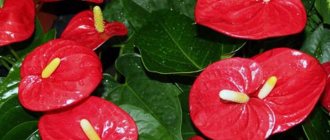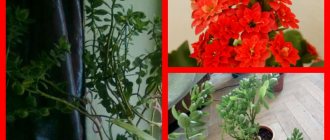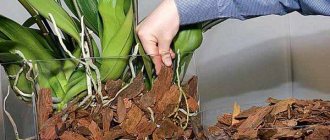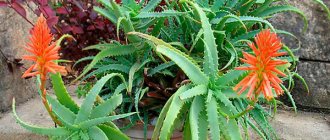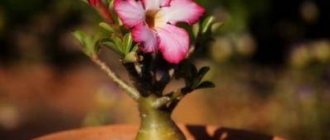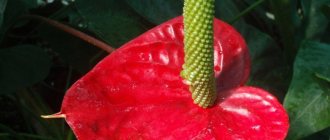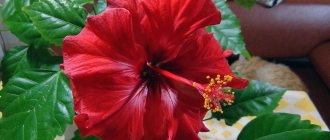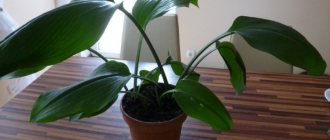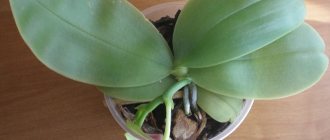Spectacular, delicate, airy, inimitable - these are the epithets that come to mind when I admire the flowering of clerodendrum. He has been living with me for 4 years, but I just can’t get used to this miracle. A neighbor gave the flower when she moved. She didn’t tell me anything about him, assuring me that I would figure it out myself. I started looking for information and learned a lot of interesting things. In particular, there is a very beautiful legend associated with the flower, and it does not bloom in every home. I hasten to share with you the features of caring for the “tree of destiny”.
Why doesn't clerodendrum bloom?
Why does clerodendrum not bloom?
Many flower growers believe that this flower has good energy and brings feminine happiness to the home. The green beauty is a lover of the warmth of the African and American tropics. There its vines reach up to 4 m in length, green leaves cover the entire length of the shoots every year, falling off during cold weather. The shoots become woody, which allows this plant to be grown as a tree or bush.
Flowering of a contrasting beauty
Flowering occurs from the beginning of spring until the first days of autumn. At home, you can most often find Mrs. Thompson's clerodendrum and Clerodendrum Prospero. For the Thomson and Clerodendrum Prospero species, home care is the same, they differ only in shape and color palette.
If left long, the plant may pull its shoots upward, requiring garter, or fall down from the hanging pot
The conditions for keeping the evergreen representative of the Verbenov family are simple. The lack of flowering is associated precisely with insufficient care. Main reasons:
- improper care during plant hibernation;
- improper exit from a state of rest;
- lack of fertilizing or untimely replacement of soil;
- incorrect pruning.
How Thomson's clerodendrum with red stamens and snow-white Prospero bloom
Briefly about the plant
Clerodendrum is a green vine with beautiful weaving. Translated, the flower means “tree of fate.” People may call it “innocent love.”
Clerodendrum Thomson.
The homeland of the liana can be called Africa and Asia. The leaves of the plant are shaped like a heart, the inflorescences have the appearance of a panicle. There are many types of this flower in nature, and each of them has its own exceptional and amazing aroma.
Difficulties in home care
Why do dracaena leaves turn yellow and fall off?
You should take special care of your phytofriend during periods of dormancy and recovery from it. With the onset of winter, it should be placed in a place where the temperature will be about 15 °C. Watering should be reduced to a minimum, but make sure that the soil in the pot does not dry out completely.
Important! In winter, you cannot spray, fertilize, or place the plant in a warm place.
Since watering is reduced, many gardeners forget about their indoor friend and may miss the appearance of the first buds of flower stalks. With their pipping, the active period of caring for the plant should begin, this is approximately the end of February - beginning of March:
- Mandatory pruning. The length of the shoots should be reduced by one third. If long lashes are formed, you need to remove a minimum of length; if you want to create a tree, you can leave 10 cm of shoots. The smaller the shoots of the plant, the larger and denser its flowers will be.
- Replanting or updating the top layer of soil. The flower slept in winter, and during the active period of growth it needs a lot of nutrients, which should be in its soil. Replanting is not necessary if the plant's roots have not reached the bottom of the pot.
- After transplanting and pruning, it is important to provide the clerodendrum with warmth and plenty of light.
- In conditions of awakening, the flower needs daily watering with the obligatory removal of excess water from the pan.
An example of how to prune clerodendrum correctly
How to care?
- Temperature .
Since the natural habitat of clerodendrum is a hot climate, it requires a special temperature regime of 18–25°C during the flowering period. But you should avoid direct sunlight, which can harm the plant. It is better to place the flower on windows facing east and west. If the window is south-facing, additional protection from exposure to bright sun will be required. - Humidity . For lush and regular flowering, the plant requires a constant high level of humidity. The flower should be sprayed regularly. You can place the flower pot in a tray filled with damp moss.
- Watering . Watering should be regular, but the plant should not be flooded. You just need to make sure that the earthen ball is always slightly moist and does not dry out. In winter, watering is reduced to 2 times a month. You should not place the plant next to radiators.
- Feeding . It is necessary to feed clerodendrum during the flowering period 2 times a month with complex fertilizers.
Trimming .
In order for the plant to have a beautiful shape and bloom luxuriantly, it requires regular pruning. Shoots that are too long need to be shortened by 10-15 cm. This will stimulate the formation of new branches and inflorescences. Pruning is also necessary because the plant can grow up to 3-4 meters in height, so its growth must be limited. The shape and size of the plant must be adjusted based on the available space in the room where it grows.- Transfer. Replanting a flower should be done only after pruning. Clerodendrum does not like it, so this procedure must be done with extreme caution. It is best to do this once every 2 years.
With each transplant, the plant pot should be 2-3 cm larger in height and width. A 3 cm thick drainage is required. The support must be installed directly into the pot.Advice! The safest and least traumatic way to transplant clerodendrum is to transfer it with a lump of soil on the roots.
It is better to buy universal soil for flowering plants in a store. But you can prepare the substrate at home: peat, leaf soil and sand in equal proportions.
Below you can watch a video about caring for this plant:
Transfer
Why do cyclamen leaves turn yellow when it blooms?
It needs replanting annually, since the root system is very developed and grows quickly. More often than not, it looks more like a transshipment than a transfer. The roots of the plant are very delicate, it is better not to touch them.
Note! You cannot remove the roots too much from the soil, as you can damage them, which can also cause a lack of flowering.
The flower is picky about soil: it needs nutritious, slightly acidic soil. To create these conditions, you need to mix in equal parts:
- clay soil;
- leaf soil;
- peat;
- coarse sand.
Note! Before transplanting, the soil is disinfected with steam or in the oven.
Reproduction
The plant can be propagated in two ways:
Seeds
This method is a little more complicated than the previous one, but no less effective. Seeds are planted in February - March in containers with substrate and covered with film. In this way, greenhouse conditions are created.
To avoid stagnation of moisture, the seeds must be watered and ventilated periodically. Also, seedlings should have good lighting.
After two months, the first sunrises will appear, and when they grow four leaves, they are transplanted into small containers. After good rooting, the seedlings are moved to larger pots and accustomed to new conditions.
Cuttings
If you already have clerodendrum, you will not need the seed propagation method, because you can always get cuttings for rooting when pruning in spring. Clerodendrum cuttings root easily in water, especially in spring and summer. Once the cuttings have taken root, they are planted in pots approximately 7 cm in diameter and grown under a glass cover, keeping the substrate moist.
As soon as the root system develops and shoots and leaves appear on the cutting, the cutting with the root ball is transferred to a pot with a large (9 cm) diameter, in which it will grow until spring without a cap. A year from the beginning of rooting, transfer the plant to a pot with a diameter of 11 cm in soil for an adult clerodendrum. During this time, be sure to pinch the shoots at least twice to stimulate the growth of side branches.
Conditions for lush flowering
Why do indoor balsam leaves turn yellow?
Flower growers, wondering why their Thompson clerodendrum does not bloom, attribute capriciousness and a difficult character to the plant. And it just requires similar conditions to its native home: light, warmth, humidity and abundant watering that does not linger in the roots.
- It will not be difficult to provide it with light; it feels great on a western or eastern window, the main thing is diffused lighting. During the winter dormant period, it does not need abundant light. But when emerging from hibernation, a lack of light can cause flower buds to fall off.
- The temperature in summer should be 20-25 °C. During the rest period, the temperature should not exceed 18 °C, ideally 12 °C.
- High humidity should be maintained by frequent spraying and a damp layer of expanded clay in the base of the pot. When spraying, it is important that water does not fall on the inflorescences.
- Abundant watering begins in early spring after pruning and replanting the plant. With the onset of the dormant period, along with a sharp drop in temperature, watering is also reduced.
- Complex fertilizer for flowering plants will provide all the necessary minerals and trace elements during active flowering and growth.
Important! There is no need to fertilize during the autumn and winter periods, since the plant can go into active growth and skip the period of sleep, and with it the formation of buds with future flowers.
Clerodendrum - a flower for a good mood
It is interesting that clerodendrum began to be grown as an indoor flower relatively recently, acquiring the well-deserved love of flower growers. Interior designers also did not ignore this touching and delicate plant. It looks great in winter gardens and interiors with a touch of romance.
They say that contemplating its flowers not only brings aesthetic pleasure, but also gives thoughts a positive attitude, relieves stress and excessive irritability. I confirm!
The plant has several popular names, for example, “innocent love” or “volkameria”. At first it seemed strange to me that the main nickname was the “tree of fate,” although in structure my clerodendrum is a pronounced liana. It needs support and space, then flexible branches with dark green embossed leaves can stretch up to 3 meters.
I have Thompson's clerodendrum (Clerodendrum thomsoniae) growing, and my friends' Philippine one has taken root quite well. Having become interested, I learned that there are also tall species that fully justify the word “tree” in the name:
- most beautiful;
- fragrant;
- Ugandan.
All types of clerodendrum have a subtle, pleasant aroma with a unique shade, which is attributed to antidepressant properties.
The history of the plant goes back to Ancient Rome, where clerodendrum was dedicated to Venus, revered and tried to be grown in large quantities. Officially, the tropics of Africa, Asia and South America are called its homeland. It is not possible to determine the origin more precisely.
Clerodendrum has several popular names, for example, “innocent love” or “volkameria”. © onlineplantguide
Clerodendrum: how to make it bloom
There is one secret what to do to make indoor clerodendrum bloom. There is one sure way to provoke flowering - pruning.
The first buds to appear on the plant are the flower buds, and then the leaf buds. If the plant does not produce them on its own in early March, the plant should be pruned. Pruning must be done sparingly, the shorter the better. After the procedure, the plant should be transplanted into fertile soil. With this method of breaking dormancy, leaf buds first appear and its large green leaves begin to open, followed by active growth of flower buds.
When and how does flowering occur?
ATTENTION: The plant begins to bloom in early June. The end of flowering is usually in September. But there are types of vines that can bloom all year round.
These beautifully flowering vines are rich in a variety of inflorescence shapes and have a multifaceted palette of colors. For example, Thompson has bright white and crimson flowers. The Beautiful Clerodendrum has purple flowers collected in paniculate inflorescences. And Fragrant blooms with fluffy white-pink flowers and, with proper care, its flowering continues all year round.
Why do clerodendrum leaves turn yellow and fall off?
Why do clerodendrum leaves turn yellow, and what to do in this case:
- During the spring and summer periods, the leaves will turn yellow with poor watering. It should be made plentiful.
- If the leaf blade does not turn completely yellow, but only yellow dots appear, the problem is not watering. This is a sign of the disease chlorosis. The plant lacks iron in the soil and fertilizing; you need to add this element to restore color. Sometimes chlorosis occurs when there is a sharp change in temperature at different times of the day.
- If the leaves of clerodendrum lighten and fall off at the beginning of autumn or the dormant period, this is a normal phenomenon for clerodendrum. It prepares for winter and reserves strength, so it allows the foliage to turn yellow and fall off.
Lack of care leads to loss of healthy appearance
Features and appearance
Clerodendrum is a perennial from the Verbenov family. "Clerodendrum" is translated from Greek as "tree of destiny."
The natural habitat of this evergreen, deciduous vine is the territory of Africa and Asia. Clerodendrum leaves are heart-shaped and arranged oppositely on the stems . The flowers of this plant are most decorative; they are collected in corymbs or paniculate inflorescences. Each variety of vine has its own unique delicate aroma.
One of the most beautifully flowering representatives of cledorums is Clerodendrum Philippine. This is the most decorative and unpretentious species for keeping indoors.
In Clerodendrum Philippine, flowering begins in mid-spring and continues until the last month of summer . White-pink inflorescences are collected in a large dense bouquet with a diameter of up to 20 cm.
The buds in the bouquet are about 2-3 cm, very similar to small roses with dense petals. Thanks to them and the dark green velvety leaves, this type of clerodendrum looks very decorative.
When the plant blooms, a very strong and pleasant aroma spreads around it, very similar to the smell of jasmine, especially at night. Therefore, it is better not to place this flower in the bedroom. The dormant period of this species is shorter than that of other clerodendrum species.
Clerodendrum: proper pruning
Pruning is an important procedure for this flowering plant friend. It is on young shoots that good flowers form. To provoke the growth of young shoots, you need to cut off the old ones. The shoots should be shortened by at least 1/3 of the length.
Using pruning, you can form a tree, bush or long vines that will entwine the support
Even though clerodendrum requires attention at the beginning of spring, it rewards this care with beautiful flowering. Its flowers look bright and festive and exude a honey aroma. This is a worthy decoration for any home.
Diseases and pests
The main problem of many novice gardeners is frequent watering in cool weather, non-compliance with the light regime, and drafts. Temperature disturbances are frequent, causing the clerodendrum to turn yellow and dry out or, conversely, rot.
Among flower pests, the most active are aphids, spider mites and scale insects. Aphids do not appear on their own: they are brought with other plants or on clothing. The parasite sucks out the sap and kills the plant. Leaves infected with aphids begin to curl.
They fight aphids using laundry soap: rub the bar on a grater and add it to water 1:1. This concentrated solution is diluted again, poured into a spray bottle and sprayed with clerodendrum. Large leaves can be wiped by hand.
Spider mites are greenish-brown insects with a round, bristly body. They hide at the bottom of the leaves and are difficult to see. But their masonry is noticeable from inside the leaves. A soap solution and an infusion of onion and garlic peels help get rid of them.
Onion feathers are boiled in water and diluted with water one to one, the plant is sprayed with this solution. Similar actions with garlic. It is not recommended to use a solution of hot pepper, since it can burn the tender shoots of clerodendrum.
If the mite population is too high, you will have to resort to chemicals. “Fitoferm”, “Karbofos” are the best chemicals. The soil must be replaced and the vessel filled with boiling water. 2 ml of karbofos are diluted in a liter of water.
Greens are treated by spraying from a spray bottle. The treated flower is covered with polyethylene for 3 hours. The frames and window sill, that is, the place where the flower lived, are treated with a solution of karbofos.
Scale insects - insects with a translucent body in the form of a plate - are capable of eating an adult plant a meter long in a couple of weeks. It is difficult to fight scale insects; it is better to use the chemical agent “Aktellik”. 2 ml are dissolved in a liter of water and immediately treated: all insects are collected by hand and thrown away. Then the entire plant is watered heavily with the solution, the remainder is added to the substrate.
Important! If the plant has managed to lose 2/3 of its foliage, its death is inevitable.
Parasite attack
Chamelacium - home care and flowering
Pests are frequent guests on the plant. The most common among them:
One of the pests is the spider mite.
- whitefly Leaves behind a white coating. The foliage and flowers dry out from it. The plant is treated with insecticides, and the affected parts are removed by insects;
- spider mite It's difficult to see him. Cobwebs in the internodes and limp leaves indicate its appearance. Minor damage can be repaired using laundry soap. Insecticides will help with large levels of damage. To avoid such situations, you need to spray the leaves with water every day;
- scale insect. It can be found on stems and leaves. It protects eggs and itself with a shell, so it is very difficult to resist. To do this, first, parasites are collected by hand, and then the flower is treated with an insecticide;
- aphids are the most popular parasite. It causes the plant to wither by sucking the juices out of it. The entire plant is treated with insecticides, and the affected areas are removed.
Important! Whiteflies, aphids and spider mites are the most important enemies. If corresponding signs are detected, it is necessary to urgently treat the soil with an insecticide. If the degree of damage to the plant is high enough, then it is better to carry out the procedure several times. After spraying, it is recommended to remove the plant from direct sunlight and cover it with a cloth. Clerodendrum can also be placed in a greenhouse for several days.
Why doesn't it bloom
Sometimes clerodendrum does not bloom. The reasons mainly come down to improper care. Maybe:
- The flower was disturbed during dormancy - kept warm or in a draft, the roots were watered too much. If the sleeping conditions are disturbed, the clerodendrum will not bloom in the spring.
- The liana has not been replanted for a long time. If the plant has been in one place for more than 5 years, it may wither.
- The soil has exhausted its resource and there are no nutrients left in it. It is necessary to completely replace the soil and fertilize it.
- Clerodendrum was not fed. Additives are needed once every two weeks, organic and mineral fertilizers are alternated. Potassium and fluoride are definitely needed. Nitrogen is given only at the very beginning of flowering. Feeding in the fall is reduced and not carried out until February.
- The plant, on the contrary, was overfed, and it does not want to bloom.
- The soil composition is too alkaline or too acidic.
- The pot is too huge, and the clerodendrum takes root, gaining mass.
- The shrub has just been transplanted and is feeling stressed.
- The reason is simple - drought. If a plant is thirsty, it will not bloom.
- The flower is attacked by pests and slowly dies.
In all these cases, clerodendrum will not bloom. In September it goes into retirement and stops flowering in winter.
In ancient times, clerodendrum was planted in honor of the goddess of love Aphrodite, and temples and statues were decorated with flowers. Nowadays it is valued no less, because it is very beautiful and already has more than 300 varieties.
Clerodendrum varieties with photos
Clerodendrum Thompson
Clerodendrum Thompson - a tropical vine on your windowsill. The plant's homeland is equatorial Africa. it grows right in the rainforest. An interesting feature: the forest is in twilight, but the plant needs light to grow. As a result, it began to weave through the trees and reach the sun.
Many years of evolution have not been in vain. Clerodendrum came to us without a hard trunk. Its shoots are thin, smooth, elastic. At home, the plant needs support; it will weave around the support and bloom profusely.
Clerodendrum Thompson has dense green leaves with slightly ribbed edges. You can buy the plant at a flower shop or garden center. The species offered by establishments grow as bushes. which is convenient for the location in the apartment.
Note that this form will not last long. In stores, plants are fed with growth hormones. After the effect of the substances ends, Clerodendrum will turn into a vine and will weave around the support.
The plant can be grown as a green carpet. But, it needs to be pinched and trimmed regularly. It will branch, thick, beautiful shoots will grow.
Clerodendrum paniculata
This name hides a tree with large heart-shaped leaves. “Small” comes from Asia, but this does not stop him from living on the windowsill of an apartment. The plant can stand in both sunny and dark places. Clerodendrum flowers are collected in inflorescences. In appearance they are similar to the roof of pagodas.
If you water it regularly and stir up the soil in the pot, it will bloom profusely and for a long time. For winter, the plant is pruned almost at the root. In spring, new shoots with flowers at the end grow on it. For unknown reasons, Clerodendrum “Fine” is rarely grown at home.
Clerodendrum Beautiful
This species is a hybrid of Clerodendrum brilliantum and Thompson. It has long and thin shoots, cup-shaped inflorescences. The leaves of this handsome plant are hard and dark green in color. It gets along well on the kitchen window sill in the apartment.
Clerodendrum Fragrant
The plant lives in the forests of China and Japan. Clerodendrum came to our country several decades ago. The plant has thin, flexible shoots and double flowers of pink or white. In the morning, the plant smells of citrus or violets. That's why it got its name.
If the plant is planted in a large pot it grows quite quickly. Inflorescences take a long time to form at the tips of the shoots. In order for clerodendrum to bloom profusely and for a long time, during the flowering period it is generously watered and fertilized.
The leaves can grow to the size of a plate. It will be difficult to raise such a giant in an apartment. The plant is periodically pruned so that it grows wider, like a bush. In winter, the plant can be kept in a bright room, at a temperature of at least 15 degrees.
Clerodendrum Ugandan
Ugandan clerodendrum can grow in offices, large rooms, and it can also be grown in an ordinary apartment. The plant came to us from East Africa. In nature, the plant grows in the mountains. The plant blooms twice in summer, at the beginning of June and at the end of August.
Clerodendrum "Ugandan" is incredibly beautiful. Thin blue stalks and weightless flowers that resemble butterflies. If the plant is properly cared for, the flowers gather in lush inflorescences. In an apartment you can grow flowers up to 20 centimeters in size. If the plant grows in a greenhouse, the size of the flowers reaches up to 45 centimeters.
Clerodendrum Walich
This plant variety has different names: “Cleopatra’s Tears”, “Bride’s Veil”, “Prospero”. The birthplace of the flower is India. With proper care, he gets along well in our apartments. Clerodendrum Walich grows as a small bush. There won't be any big escapes from it, so you don't have to worry about space on the windowsill.
The plant should be protected from direct sunlight. They can cause burns on the leaves. Also be careful about watering. The plant does not like to be flooded, but the flower cannot be left without moisture.
Clerodendrum is sensitive to hypothermia. At low temperatures, the leaves will begin to curl and dry out, then fall off completely. Proper care and care of the flower will allow it to delight you with flowers for a long time.
Clerodendrum philippines
This plant pleases with small fragrant roses. The homeland of the plant is China and Japan. Rarely found in domestic apartments. And in vain! In the evening and at night, the flower emits a scent similar to that of jasmine. The flowers are small, only 2-3 centimeters. They gather in large inflorescences and can reach a size of 20 centimeters. If the plant is well fed, its leaves can reach up to 25 centimeters in diameter.
Clerodendrum loves diffused light. If exposed to direct sunlight, it will die within a short time. The plant can be propagated by cuttings. New shoots take root well. Up to 30 “babies” can form around the main stem, which can be planted without harm to the donor plant.
When caring for clerodendrum, do not forget to pinch its branches. Otherwise, they stretch upward, become weak and thin. The plant blooms several times a year from spring to late autumn, if you provide it with proper care, it will delight you with lush flowers.
Clerodendrum Morning Kiss
An unusual plant that blooms all year round. Clerodendrum has velvety leaves that are pleasant to the touch and are small in size. This plant will feel great on the windowsill in the living room.
Growing problems
Clerodendrum is not afraid of diseases - it is resistant to most fungi, viruses and infections. Common houseplant pests such as aphids, spider mites and whiteflies can be dangerous. If insects are detected in a timely manner, a single treatment with an insecticide will help.
Much more often you have to deal with the consequences of poor, neglected care. The main problems, their causes and solutions are listed in the table below.
Table - Problems when growing clerodendrum
| Problem | Probable Causes | Help the plant |
| Yellowing of leaves | — Lack of moisture in the soil; — Dry air in the house; — Too much fertilizer; - Lack of light; — Direct sunlight | — Regular watering; — Systematic watering; — Adjustment of care in accordance with recommendations |
| The leaves wither and fall | — Severe drying of the soil | — Maintain constant soil moisture |
| The leaves turn black | — Fertilizers burn roots — Root rot | — Replant by removing damaged roots |
| The plant sheds leaves and buds in summer | - Humidity; — Lack of water; — Low air humidity; — Lack of nutrients | — Regular spraying with warm water; — Regular fertilization with mineral and organic fertilizers |
| Leaf chlorosis (leaf wrinkling, curling, spots) | — Micronutrient deficiency | — Spraying with iron fertilizers |
| The shoots stretch out, the leaves wither. | — Light fasting | — Move the plant closer to the window; — Increase the amount of light |
| Spots appear on the leaves | - Sunburn; — Pests; - Cold air; - fungus | — Check for pests and plaque; — Move to a warm place, protected from the sun |
Since Thompson Clerodendrum is quite easy to care for, it can be used to decorate offices. It looks very impressive in large, well-lit rooms.
